The integration of programming into civil engineering is transforming the industry. We can design complex infrastructure projects and analyse large datasets. Imagine revolutionizing the way we build our cities and infrastructure, all by the power of coding. Programming skills are no longer just a bonus—they’re a game changer in this era.
Technology is revolutionizing civil engineering by integrating advanced tools and techniques. Programming allows for the automation of repetitive tasks, enhancing the accuracy of designs, simulations, and analyses. With the advent of artificial intelligence and machine learning, engineers can now predict structural behaviors under various conditions, optimize material usage, and improve project planning.
List of Popular Programming Languages for Civil Engineers
- Pyhton
- MATLAB
- R
- JavaScript
- C/C++
- SQL

Deep Dive into Top Languages for Civil Engineering
| Languages | Strengths | Weaknesses | Ideal Use Cases | Integration with Tools |
|---|---|---|---|---|
| Python | Easy to learn, extensive libraries | Slower execution speed | Data analysis, automation, simulation | AutoCAD, GIS tools |
| MATLAB | Powerful numerical analysis, extensive functions | Expensive, steep learning curve | Structural analysis, data visualization | Engineering software |
| R | Strong for statistical analysis, great visualization | Less general-purpose, slower | Environmental data analysis, statistical modeling | Data analysis tools |
| JavaScript (Node.js) | Web development, interactive visualizations | Not suited for heavy computations | Project management tools, interactive maps | Web-based platforms |
| C/C++ | High performance, control over resources | Complex syntax, steep learning curve | Simulation software, real-time processing | Custom software development |
1. Python for Civil Engineers
Python can be used for automating repetitive tasks, performing data analysis, creating simulations, and developing custom tools. For example, engineers can automate the process of data extraction from CAD files or to simulate the structural response of buildings under different load conditions. It also integrates well with engineering software such as AutoCAD and various GIS tools.
Experts Opinions:
- “Python’s versatility and ease of use make it an invaluable tool for civil engineers. It has significantly improved our workflow efficiency.” – Jane Doe, Structural Engineer
- “The integration of Python with GIS tools has been a game-changer for urban planning projects, providing robust analysis and visualization capabilities.” – Mark Roberts, Urban Planner, as discussed in the Journal of Urban Technology.
Use Cases
- Data Analysis: The data manipulation capabilities allow civil engineers to handle large datasets efficiently, enabling more informed decision-making.
- Machine Learning: Engineers can implement machine learning algorithms to predict structural failures, optimize resource allocation, and improve project outcomes.
- Automation: Python scripts can automate repetitive tasks such as data collection, processing, and reporting, saving time and reducing the potential for errors.
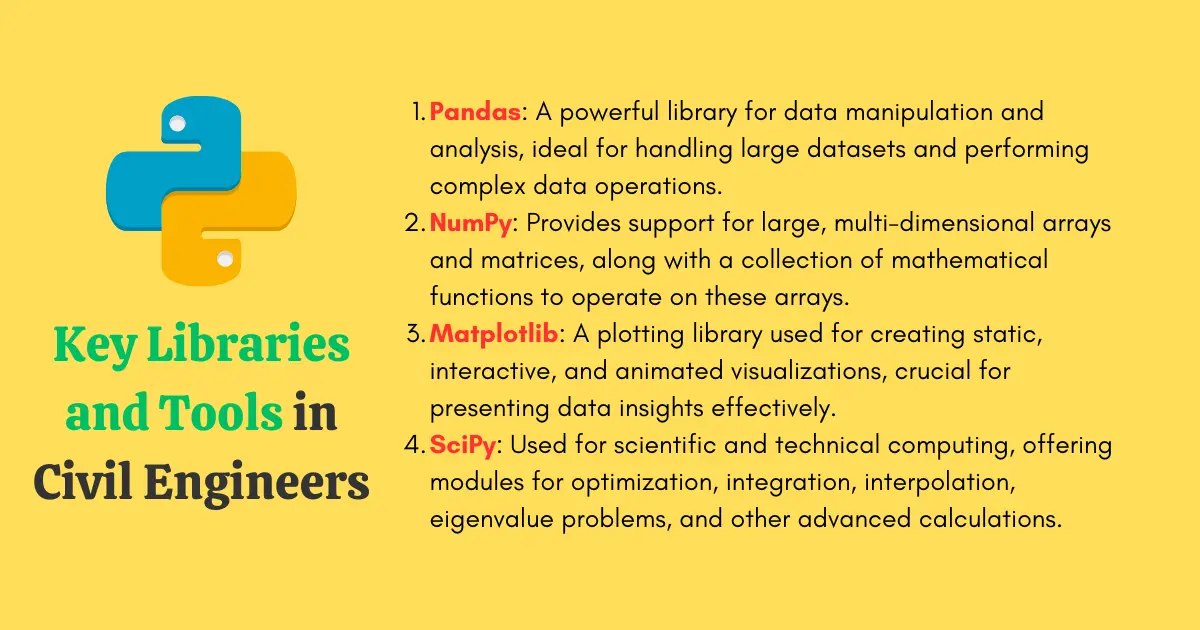
How Can Python be Used in Civil Engineering?
Many civil engineering firms use Python to streamline their workflows. For instance, a construction company might use Python scripts to analyze real-time data from construction sites, helping project managers make informed decisions quickly.
2. MATLAB for Civil Engineers
MATLAB is ideal for structural analysis, simulating physical systems, and data visualization. Engineers can use it to model the behavior of complex structures, analyze the impact of environmental factors, and visualize data in 2D and 3D plots.
Experts Opinions:
- “MATLAB’s powerful computational abilities are unmatched when it comes to structural analysis and simulation tasks.” – John Smith, Civil Engineering Professor
- “MATLAB’s ability to handle complex calculations and simulations has made it indispensable in our seismic analysis projects.” – Sarah Lewis, Structural Engineer, featured in Engineering Structures Journal.
Use Cases in Civil Engineering
- Numerical Analysis: Excels at performing intricate numerical calculations, solving differential equations, and conducting finite element analysis.
- Simulations: Engineers use MATLAB to simulate structural behaviors under various load conditions, enabling the design of safer and more efficient structures.
- Design and Analysis of Systems: It’s capabilities in system modeling and control design help engineers optimize infrastructure systems, from water distribution networks to traffic flow management.
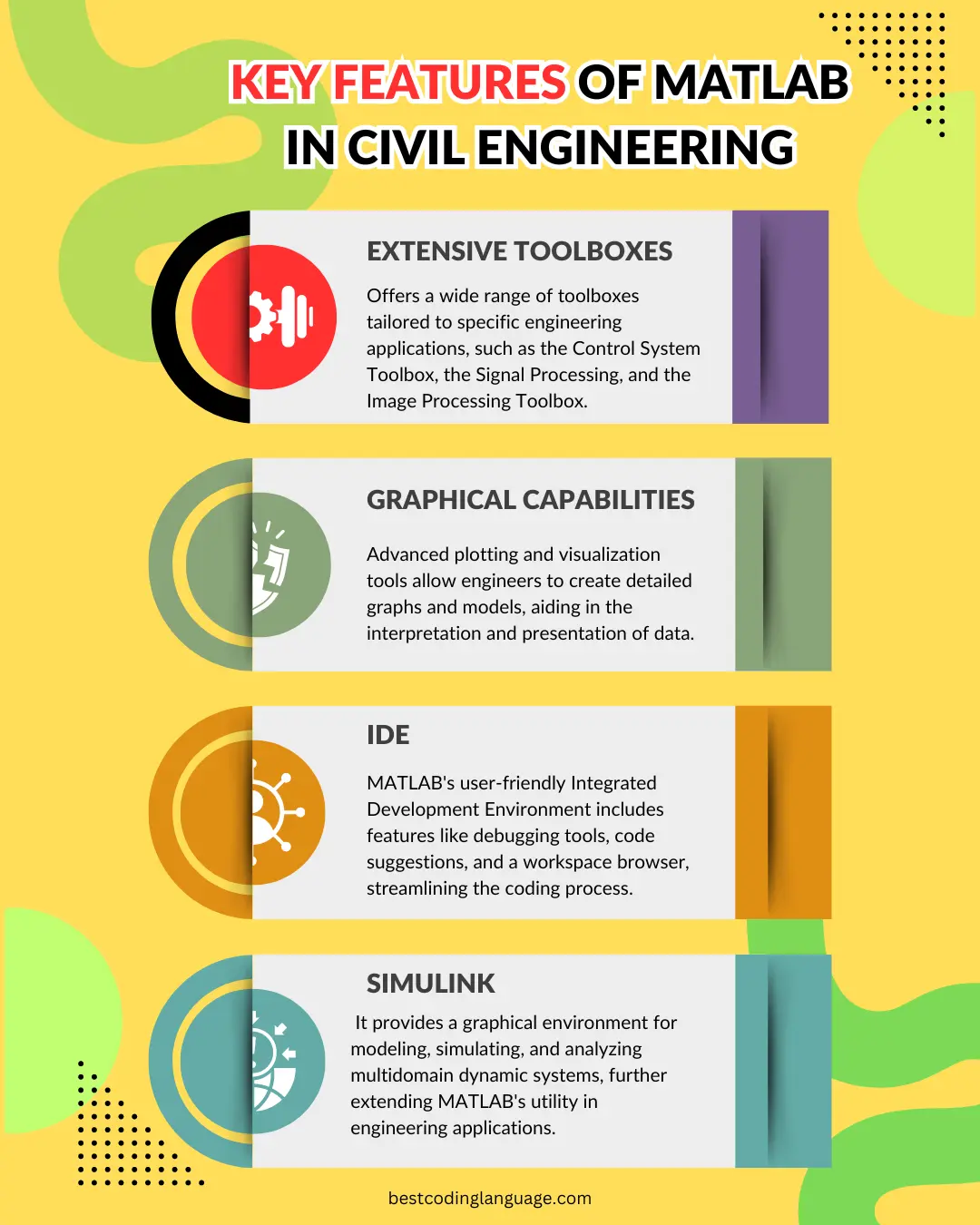
How MATLAB Can be Use in Civil Engineering?
In research, MATLAB is often used to simulate the structural integrity of new materials. For example, civil engineers might use it to model how a new type of concrete will behave under various stress conditions.
3. R for Civil Engineers
R is commonly used to analyze environmental data, traffic patterns, and structural health monitoring data. Engineers can create detailed statistical models and visualizations to better understand and present their findings. It has a sizable community and extensive libraries.
Experts Opinions:
- “R’s prowess in statistical analysis and data visualization makes it a crucial tool for analyzing traffic patterns and improving urban infrastructure.” – Dr. Alice Green, Transportation Engineer, as mentioned in the Transportation Research Record
- “The flexibility of R in handling large datasets and creating detailed visualizations has significantly improved our environmental impact assessments.” – John Martinez, Environmental Consultant, in an article on Environmental Monitoring and Assessment
Use Cases in Civil Engineering
- Data Analysis: It is ideal for handling, analyzing, and visualizing large datasets, providing civil engineers with the insights needed to make data-driven decisions.
- Environmental Engineering: Used to model and analyze environmental data, such as air and water quality measurements, to assess the impact of engineering projects on the environment.
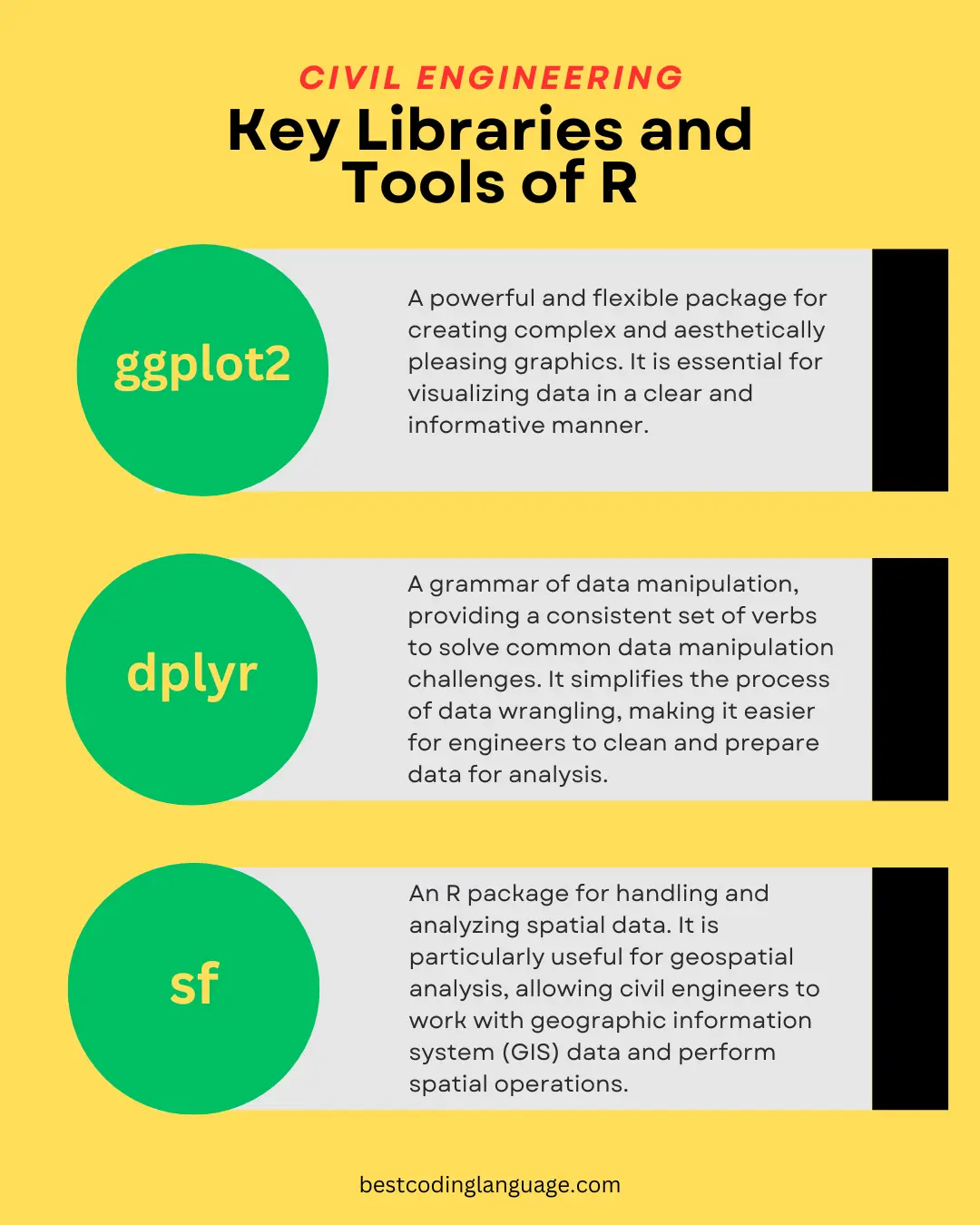
How R Can be Use in Civil Engineering?
Environmental engineers often use R to analyze and visualize pollution data, helping them identify trends and make data-driven decisions.
4. JavaScript for Civil Engineers
JavaScript along with Node.js can be used to build project management tools, interactive maps, and data visualization dashboards. It allows engineers to develop web-based tools that can be accessed remotely and used for various engineering tasks.
Experts Opinions:
- “Using JavaScript and Node.js, we’ve developed interactive dashboards that greatly enhance our project management capabilities and data sharing among stakeholders.” – Laura Adams, Project Manager, as reported in Civil Engineering Magazine
- “JavaScript’s ability to create dynamic web applications has been pivotal in developing our interactive mapping tools for urban development projects.” – Chris Johnson, GIS Specialist, featured in the Journal of Urban Planning and Development
Use Cases in Civil Engineering
- Building Interactive Web Applications: It is ideal for creating interactive project management tools, allowing civil engineers to track progress, manage resources, and collaborate in real-time.
- Visualization: The visualization libraries enable the development of interactive models and simulations, helping engineers to visualize complex data and design parameters directly in web browsers.
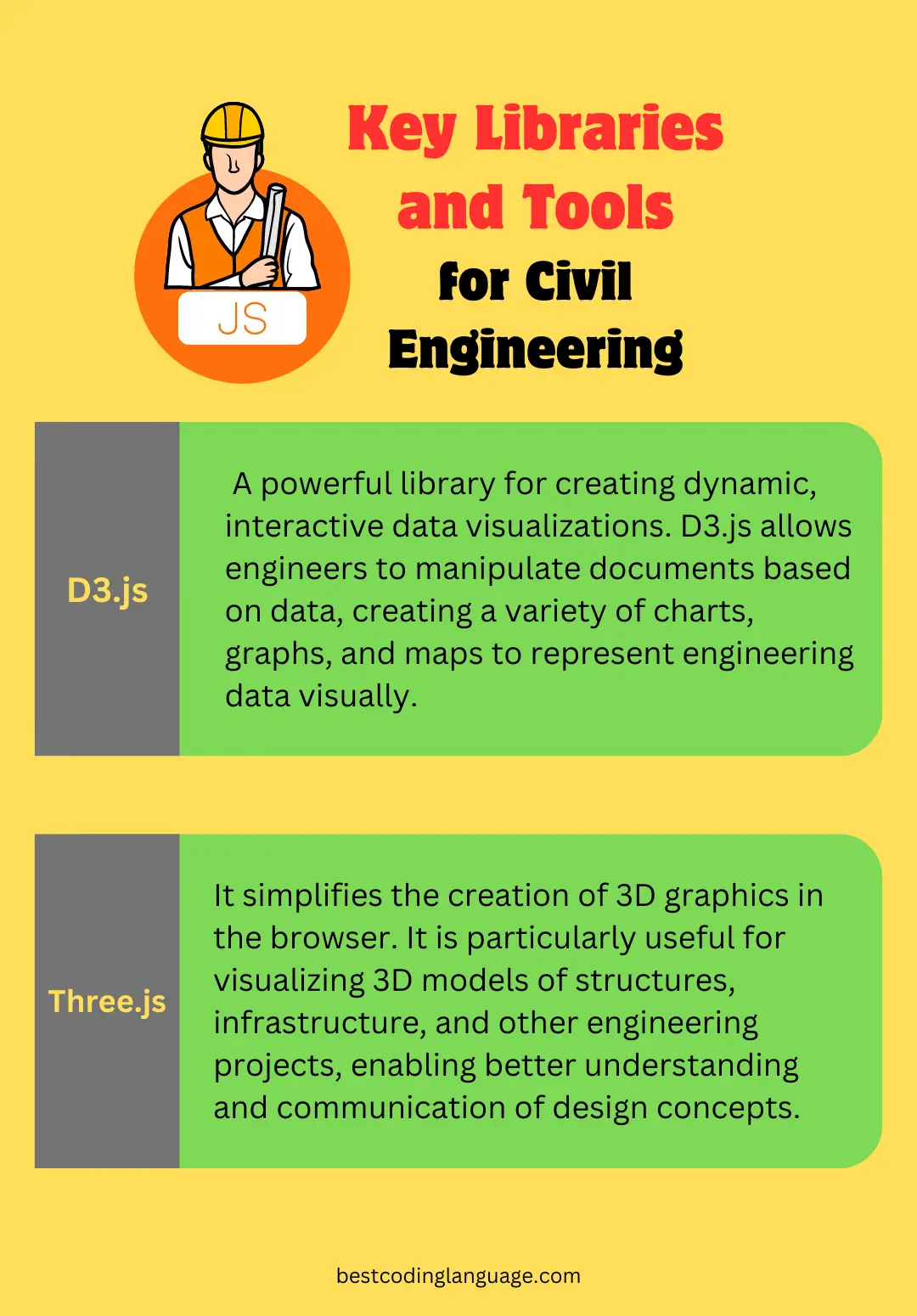
How JavaScript Can be Use in Civil Engineering?
A civil engineering firm might develop an interactive map using JavaScript to visualize the progress of multiple construction sites, providing a centralized view for project managers and clients.
5. C/C++ for Civil Engineers
C/C++ are used for developing custom simulation software, real-time data processing applications, and embedded systems in smart infrastructure. These languages provide control over system resources and are ideal for developing software that requires heavy computations and real-time data processing.
Experts Opinions:
- “C++’s high performance and control over system resources are critical for developing real-time simulation software used in bridge engineering.” – Dr. Robert Wilson, Bridge Engineer, as discussed in the Journal of Bridge Engineering
- “For embedded systems in smart infrastructure, the efficiency and speed of C programming are unmatched, providing reliable performance for monitoring and control systems.” – Linda Brown, Smart Infrastructure Developer, in IEEE Transactions on Smart Grid
Use Cases in Civil Engineering
- Simulation: C++ is extensively used for developing simulation software that models physical systems and processes, such as structural dynamics, fluid mechanics, and traffic flow simulations.
- CAD Software Development: Many computer-aided design (CAD) applications are built using C++ due to its ability to handle intricate graphical computations and provide real-time responsiveness.
Key Features

How C++ Can be Use in Civil Engineering?
In smart infrastructure projects, C++ might be used to program embedded systems that monitor and control various aspects of a building’s performance, such as energy consumption and structural health.
6. SQL for Civil Engineers
SQL (Structured Query Language) is the standard language for managing and manipulating relational databases. It is designed for querying, updating, and managing data stored in a database, making it an essential tool for handling large volumes of structured data efficiently.
Experts Opinions:
“SQL is essential for managing and querying large datasets in civil engineering projects. Whether it’s for monitoring environmental data, analyzing traffic patterns, or managing construction schedules, it provides the efficiency and accuracy needed for data-driven decision making.” – Dr. Sarah White, Data Analyst in Civil Engineering
Use Cases in Civil Engineering
- Managing Large Datasets: Large datasets, like survey data, material inventories, and project documentation, are frequently encountered in civil engineering projects. SQL is utilized to store, retrieve, and alter these information.
- Project Databases: To keep all project data structured and accessible, SQL databases can be used to store technical drawings and requirements, manage resources, and track the status of projects.
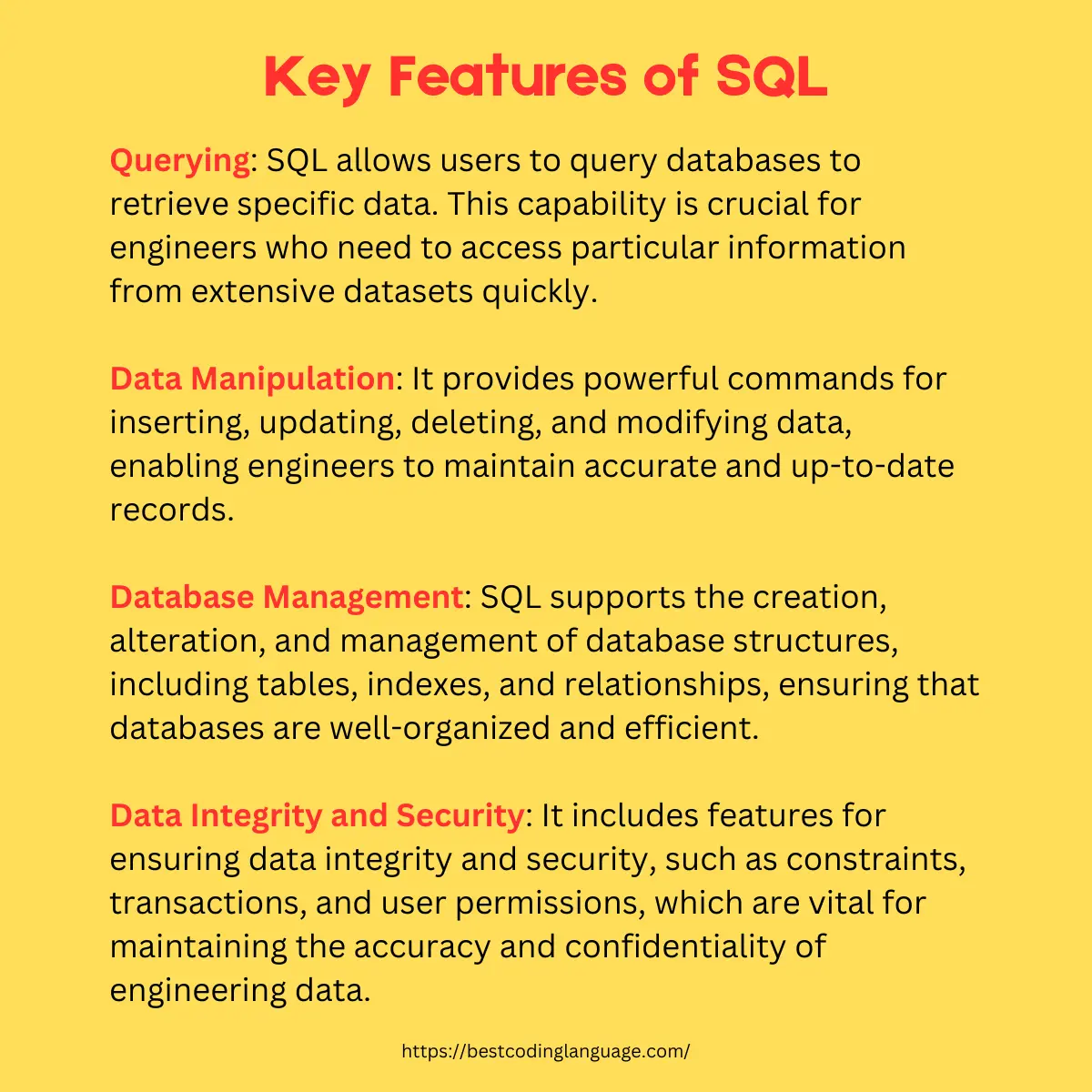
How SQL Can be Use in Civil Engineering?
A municipal government implemented an environmental monitoring system to track air and water quality in real-time across the city. The system involved numerous sensors placed at strategic locations, collecting data on pollutants, temperature, humidity, and other environmental factors.
Case Studies and Real-World Examples
Python in Structural Health Monitoring
- Project: Monitoring the structural integrity of a bridge.
- Details: Python was used to collect and analyze sensor data in real-time. Libraries such as Pandas and SciPy were employed to process large datasets and perform statistical analyses, ensuring the bridge’s safety and performance.
- Outcome: Improved accuracy in detecting potential structural issues, allowing for timely maintenance and enhancing overall safety.
MATLAB for Earthquake Simulation
- Project: Simulating the impact of earthquakes on high-rise buildings.
- Details: MATLAB was used to develop complex simulations that model the response of building structures to seismic activity. The simulations helped engineers design buildings that can better withstand earthquakes.
- Outcome: Enhanced building designs that meet stringent safety standards, reducing the risk of damage during earthquakes.
R in Environmental Impact Assessment
- Project: Assessing the environmental impact of a new highway construction.
- Details: R was used to analyze environmental data, including air quality, noise levels, and wildlife populations. The ggplot2 and sf packages helped visualize the data and assess potential impacts.
- Outcome: Comprehensive environmental reports that guided the implementation of mitigation measures, minimizing the project’s ecological footprint.
JavaScript for Project Management Tools
- Project: Developing an interactive web-based project management tool for a construction site.
- Details: JavaScript, along with D3.js and Three.js, was used to create dynamic visualizations of project timelines, resource allocation, and progress tracking. This tool facilitated better communication and collaboration among the project team.
- Outcome: Streamlined project management processes, leading to increased efficiency and reduced project delays.
C++ in Traffic Flow Simulation
- Project: Simulating traffic flow to optimize urban planning.
- Details: C++ was used to develop a simulation program that models traffic patterns in a metropolitan area. The program helped urban planners design road networks that reduce congestion and improve traffic flow.
- Outcome: Improved urban planning decisions that led to more efficient road networks and reduced traffic congestion.
SQL for Construction Project Databases
- Project: Managing a large-scale construction project database.
- Details: SQL was employed to create and maintain a comprehensive database that tracked all aspects of the construction project, including inventory, workforce management, and project milestones.
- Outcome: Enhanced data organization and accessibility, leading to better project oversight and management.

Keep Learning
Frequently Asked Questions
How can civil engineers benefit from learning programming languages?
They can enhance their efficiency and precision by automating repetitive tasks, conducting sophisticated analyses, and creating custom software solutions tailored to specific project needs.
Why is programming important in civil engineering?
It enables them to tackle complex calculations, model simulations, and manage large datasets, leading to more innovative and accurate engineering solutions.
How will programming skills shape the future of civil engineering?
Programming skills will drive innovation by enabling the development of smart infrastructure, enhancing data analysis, and automating complex processes, leading to more efficient and sustainable projects.
What emerging technologies in civil engineering rely on programming?
Emerging technologies that depend on programming include Building Information Modeling (BIM), Internet of Things (IoT) for smart infrastructure, and advanced simulation software.
How can machine learning and AI be integrated into civil engineering projects?
Machine learning and AI can be integrated by using them for predictive maintenance, optimizing design processes, and analyzing large datasets to inform decision-making and improve project outcomes.
